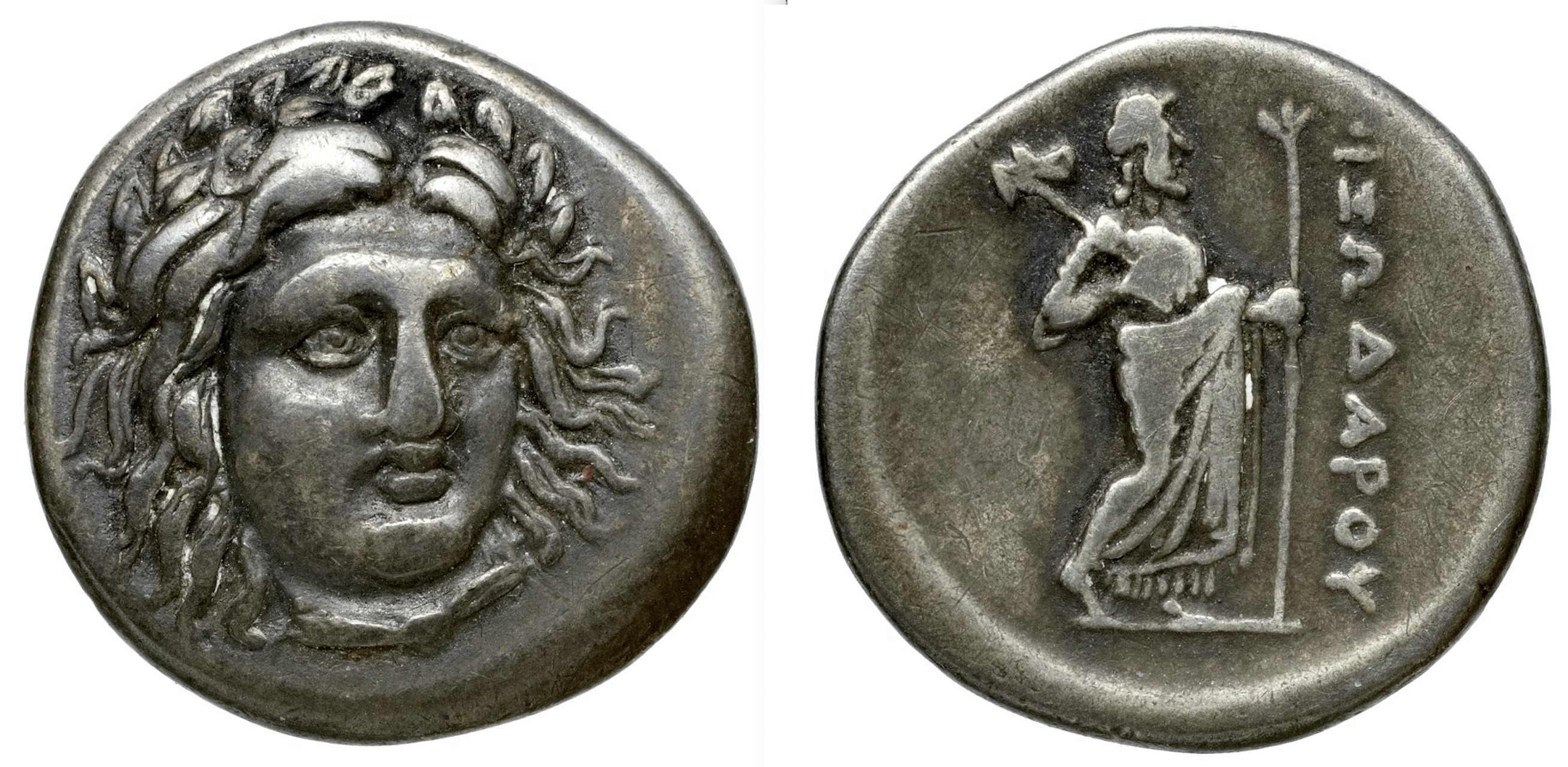Halicarnassus (Pixodarus), silver, drachms (Apollo/Zeus Labraundos) (340-335 BCE)
From SILVER
340 BCE - 335 BCE Silver 589 kg
Description
| ObverseInscription or printing placed on the obverse.: | Head of Apollo facing slightly right, wearing laurel wreath, drapery at neck. |
| ReverseInscription or printing placed on the reverse.: | ΠYΞOΔAPOY (Greek).Zeus Labraundos, wearing a chiton, a himation draped over his arm holding a double axe and a scepter. |
Mint and issuing power
| MintIdentifies the place of manufacture or issue of a numismatic object.: | Halicarnassus | Ancient regionAncient region.: | Caria | Modern countryModern country: Turkey | AuthorityIdentifies the issuing power. The authority can be "pretended" when the name or the portrait of X is on the coin but he/she was not the issuing power. It can also be "uncertain" when there is no mention of X on the coin but he/she was the issuing power according to the historical sources: | Persian Empire, Pixodarus of Caria (satrap of Caria, 340-335 BC), Hecatomnid dynasty |
Chronology
| FromIdentifies the initial date in a range assigned in a numismatic context. | 340 BCE | toIdentifies the final date in a range assigned in a numismatic context.. | 335 BCE | PeriodTime period of the numismatic object.: Classical 480-323 BC |
Physical description
| MetalThe physical material (usually metal) from which an object is made.: | Silver |
Median weightMedian of the weights of numismatic objects (in grams). in grams | 3.50 | DenominationTerm indicating the value of a numismatic object. Examples: tetradrachm, chalkous, denarius.: | drachma |
StandardStandard.: |
Image

AC256 Halicarnassus .png [1]
References
| Die study referencePublication of the study: | Konuk 1998b1Konuk 1998b, n° 245-272 (D1-D6 et D12-D13). | ||
| Coin series referenceReference to coin series study: | Sear II2Sear II, n° 4967, RQEMAC3RQEMAC, n° 256 | ||
| Coin series web referenceCoin series web references: | |||
Obverse dies distribution
| FrequencyFrequency of specimen in distribution. ᵖ | Number of obversesNumber of obverse dies. ᵖ (o) | % (o) | Number of coinsNumber of coins. (n) | % (n) | Die nameName(s) of the die(s). |
| 3 | 1 | 12.5 | 3 | 5.26 | 1 |
| 4 | 1 | 12.5 | 4 | 7.02 | 13 |
| 5 | 2 | 25 | 10 | 17.54 | 5, 12 |
| 6 | 2 | 25 | 12 | 21.05 | 3, 6 |
| 8 | 1 | 12.5 | 8 | 14.04 | 4 |
| 20 | 1 | 12.5 | 20 | 35.09 | 2 |
| Total | 8 of 8 | 100 | 57 of 57 | 100 |
Reverse dies distribution
no distribution is available
Quantification
| Number of obversesNumber of obverse dies. ᵖ (o) | 8 | Number of singletons (o1)The number of singleton coins. ᵖ | |
| Number of reverse diesNumber of reverse dies. (r) | 26 | Number of coinsNumber of coins. (n) | 57 |
| Coins per obverse dieNumber of coins per obverse die. (n/o) | 7.13 | Coins per reverse dieNumber of coins per reverse die. (n/r) | 2.19 |
| Reverse per obverse ratioRatio of obverse dies divided by reverse dies. (r/o) | 3.25 | Percentage of singletons (o1)number of coins (n) divided by the number of singletons (o1) ᵖ | % |
| Original number of dies (O) (Carter 1983 formula)The estimation of the number of coins according to Carter 1983 ᵖ | 8.41 | Coins struck if 20,000 as average productivity per dieCoins made if the average productivity for obverses (according to Carter) is 20,000. ᵖ | 168,200 |
| Original number of dies (O) (Esty 2011 formula)The estimation of the number of coins according to the singleton formula in Esty 2011 ᵖ (O) | 9.31 | Survival rate if 20,000 as average productivity per dieSurvival rate if average productivity is 20,000. ᵖ | 0.00034 |
| Coverage (o = % of O) (Esty 1984 formula)Esty 1984 - coverage (% of O) ᵖ (o = % of O) | % | Die productivity if survival rate 1/2,000Average productivity if survival rate is 1/2,000. ᵖ | 13,555.29 |
| Weight of silver (in kg) if 20,000 coins per die (O = Carter formula)Carter 1983 * Median weight * 20000 (*10 if gold or electrum) ᵖ | 589 kg <br /> 589 kg | Die productivity if survival rate 1/5,000Average productivity if survival rate is 1/5,000. ᵖ | 33,888.23 |
Remarks
Likely military
References
- ^ Konuk, Koray (1998), The Coinage of the Hekatomnids of Caria [Unpublished doctoral dissertation], Oxford.
- ^ Sear, David R. (1979), Greek coins and their values. Vol. II, Asia and North Africa, London, xlviii, p. 317-762
- ^ Callataÿ, François de (2003), Recueil quantitatif des émissions monétaires archaïques et classiques, Numismatique Romaine, Wetteren, VII + 267 p.